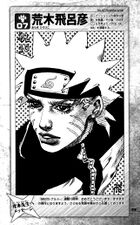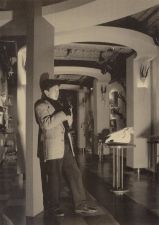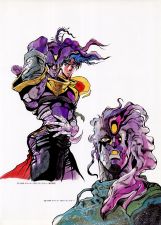Hirohiko Araki
Hirohiko Araki (荒木 飛呂彦, Araki Hirohiko) is a mangaka and author of JoJo's Bizarre Adventure, on which this wikia project is based.
Biography
Hirohiko Araki was born on June 7 1960 in Sendai, Japan. Araki left school before graduation from Miyagi University of Education.
Araki is best known for JoJo's Bizarre Adventure, published in Weekly Shonen Jump from 1987 to 2002, before the series transferred to the seinen magazine Ultra Jump in 2004.
Araki's Buso Poker was a "Selected Work" at the Tezuka Award in 1980.[1]
In 2012, Araki celebrates his 30th year as a manga artist and the 25th anniversary of JoJo’s Bizarre Adventure.
JoJo's Bizarre Adventure
The story in JoJo begins within the deceitful relationship between villain Dio Brando, arriving from a poor and abusive background, and hero Jonathan Joestar, the son of a wealthy and benevolent Lord. Attrition between Jonathan's descendants and the followers and subjects of Dio is the main source of continuity in the series; which between the 18th century and the present day visits with extensive creative license the history and cultures of England, the U.S., Italy and Japan, most prominently.
Various names, symbols, and segments of plot originating with extant music, film, literature, fashion, television, comics/manga and modern art are readily identifiable throughout JoJo in many set-ups and the background and characterization of protagonists and antagonists. Selections of scientific theory, technology, myths, belief systems, news and natural phenomena inform the functions of JoJo's multitude of unique Stand powers.
The series spans a range of genres including Science Fiction, Paranormal and the Supernatural, Mystery, Thriller, Action and Adventure. Recurrent themes include Fate; Fortunity; Justice; Redemption; Psychology; the nature and the human or creative utility of Energy, Time and Gravity; and Family or Lineage.
The situations described in the fictional Japanese town of Morioh, the base of Part IV: Diamond is Unbreakable and the ongoing Part VIII: Jojolion may represent the most up-to-date aspects of Araki's tastes and personal interests, or most personally relevant events and trends in contemporary culture (notably the 2011 Tohoku earthquake). Manga artist Rohan Kishibe, introduced in Part IV and guide in a handful of JoJo spin-offs, may represent the most self-conscious events in the story.
Among a range of motifs, JoJo maintains a number of special icons, symbols and shapes with vague or unspecified meanings, commonly used to adorn or accessorise characters. Besides the symbols that comprise "JoJo", the most recurrent of these include a five-pointed Star, a Heart, an Anchor, a Ladybird beetle, an Arrowtip, the Peace symbol, and the Palm of the hand.
Style and Influences
Araki has named Paul Gauguin and his approach and contribution to color theory as a key influence.
A consistent element of Araki's drawing is a highly dynamic treatment of the picture plane. In terms of cartooning, a comparison can be drawn between JoJo's Bizarre Adventure Part I, II and III (1987 - '92) and Tetsuo Hara's physiological ideals as exhibited in Hokuto no Ken (Fist of the North Star). Part IV ('92 - '96) exhibits a transition to a more androgynous description of human characters; Part V ('95 - '99) amends an element of haute couture; and Part VI (2000 - '03) returns to sexual dimorphism through romantic interactions.
Illustrations of the protagonists in Part VII: Steel Ball Run ('04 - '11) are powerfully reminiscent of the photographic conventions of fashion magazines and the stylings of certain celebrity personalities of the 2000s. Combination of layout with depth of field, perspective and landscape lends Part VII a particularly cinematic presentation.
Publication
Many of Araki's creations including JoJo's Bizarre Adventure have been translated and released in Europe, but so far only JoJo and Baoh have been released in the U.S., one theory being that Araki's frequent references to Western music, film and others violate U.S. copyright law. Publications by Viz Media replace certain references within the copy of the manga with thematically comparable alternatives. The American localization of Capcom's fighting games based on JoJo follow the same procedure.
Works
- Buso Poker (1980)
- Autoto Man (1982)
- Virginia ni Yohroshiku (1982)
- Magic Boy B.T. (魔少年ビーティー mashōnen bītī 1982–1983)
- Baoh (1984–1985)
- Gorgeous Irene (1985–1986)
- JoJo's Bizarre Adventure (1987—current)
- Part I: Phantom Blood (1987-1988)
- Part II: Battle Tendency (1988-1989)
- Part III: Stardust Crusaders (1989-1992)
- Part IV: Diamond is Unbreakable (1992-1996)
- Part V: Vento Aureo (1996-1999)
- Part VI: Stone Ocean (2000-2003)
- Part VII: Steel Ball Run (2004-2011)
- Part VIII: Jojolion (2011-current)
- JoJo 6251 (1993) (Artbook)
- Under Execution, Under Jailbreak (Collection) (1999)
- JOJO A-GO!GO! (2000) (Artbook)
- The Lives of Eccentrics (2004)
- Thus Spoke Rohan Kishibe - Mutsukabeza (2006)
- Front cover of Cell (scientific journal) (September 7, 2007)
- Rohan at the Louvre (2010)
- Spur Spinoff (2011)





